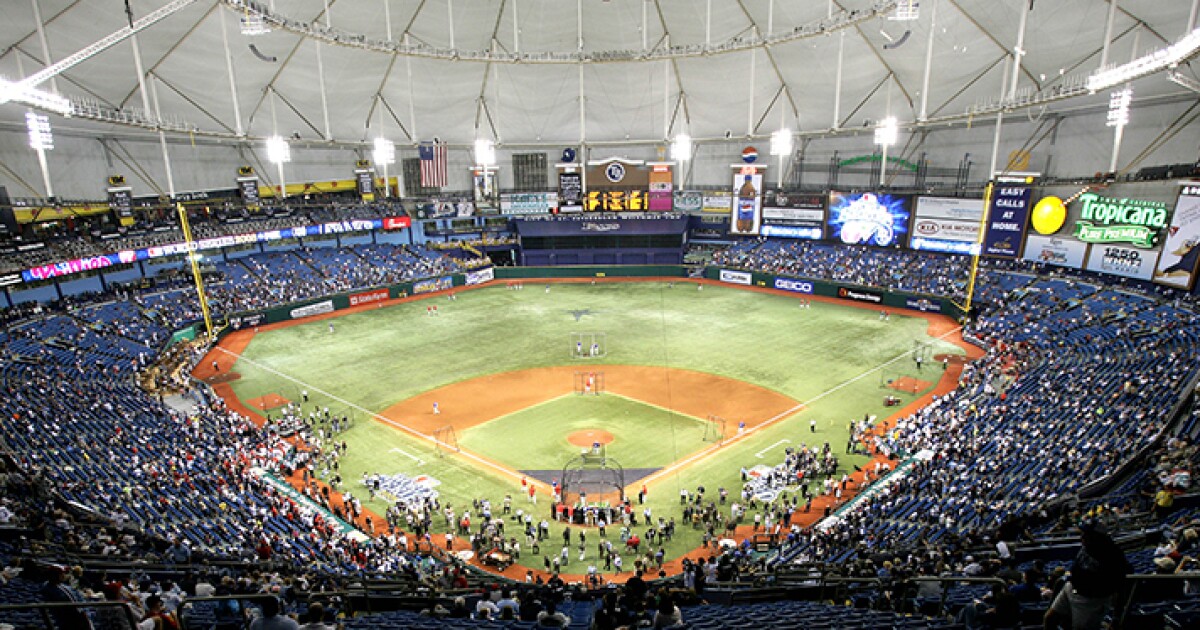Growth in stadium financing poses risks to financial, economic returns, report says
4 min read

The growth in the number of state and local government-supported stadium facilities, which reached a 17-year high in 2023, opens significant risk of adverse financial and economic consequences that could affect a city, state or county for years after the deal, Moody’s warned in a public finance sector report Tuesday.
The steady stream of proposals around the country, such as the redevelopment of Tropicana Field in St. Petersburg, Florida, the renovation of Everbank Stadium in Jacksonville, Florida, both in 2023, as well as this year’s expected plans for a new lake-front stadium for the Chicago Bears on Museum Campus, and a stadium for the Cleveland Browns, among others, all with some degree of public financing, highlight the larger debate around taxes ahead of the 2017 Tax Cuts and Jobs Act expiration next year.
Bloomberg News
“Historically, many investments in stadiums have not provided the net economic or financial benefits that governments expected,” the Moody’s report said. “The growing support of stadium projects with substantial public dollars raises the specter of an adverse financial outcome without the anticipated economic benefit.”
The risks of state and local governments issuing tax-exempt bonds to subsidize such massive city projects on behalf of wealthy team owners has been criticized by academics and economists alike, but cities and states are often keen to finance such projects in order to keep high-profile teams, hang their hat on a stadium’s capacity for economic growth and job creation.
But even local financing carries some risk. The Oakland Coliseum, which renovated with $200 million in general fund lease revenue bonds jointly issued by the city of Oakland and Alameda County, lost the Raiders in 2020 and the county was forced to sell its 50% share of the stadium to the Oakland Athletics and the city was forced to sell its 50% stake to a development group.
“Throughout the saga, the city and county paid debt service on the bonds, but nevertheless failed to retain the Raiders despite this significant operating subsidy,” Moody’s said.
“What we believe to be the real risk is the expected financial and economic benefits failing to come to fruition after a government has extended financial support to a project,” said Gregory Sobel, assistant vice president for Moody’s Ratings. “For example, if a stadium is subsidized with the expectation that a government will generate tax revenue from sales within or around the stadium, or that additional economic growth will take place because of a new stadium — and none of that occurs — that is where the risk resides. Also, if a state and local government begins to cover additional project or stadium expenses that impact its own operating flexibility, that would be a notable credit risk.”
The leagues
But when the often yearslong process of proposing, approving and building the system is all said and done, the price tag is often much higher than initially expected, Moody’s said. Plus, money from out-of-town visitors can’t be relied on.
“Sports stadiums rarely attract significant tourist spending and local fan spending largely constitutes a reallocation from other local leisure consumption options,” Moody’s said.
Many stadium projects are not just standalone developments but centerpieces of larger plans for additional development, which helps minimize credit risk.
“If the goals of these projects, such as new commercial investment and more affordable housing are met, the positive economic impact of stadium projects would be enhanced and credit risk from government bond obligations reduced,” Moody’s said.
The most expensive stadium to date offers a shining example. SoFi Stadium cost $5.5 billion to construct and is part of the 298-acre complex known as Hollywood Park, where the site also hosts the Hollywood Park Casino, the NFL’s West Coast campus, hundreds of apartments and townhouses, a movie theater and retail and food outlets. Other teams have reduced the number of seats for more flexibility, like the Nissan Stadium in Nashville, which has 9,000 fewer seats than its predecessor but aims to host 48 events per year instead of its previous 33.
“Still, the potential economic benefits of newer stadium projects and surrounding development will take time to materialize,” Moody’s said. “Potential growth in taxable bases and subsequent collection of property tax revenue will lag behind the launch of projects. Moreover, sales tax revenue will take time to grow as retailers lease space in newly built spaces. As such, we view large stadium bond issuances as credit neutral, at best, at the time of issuance.”







